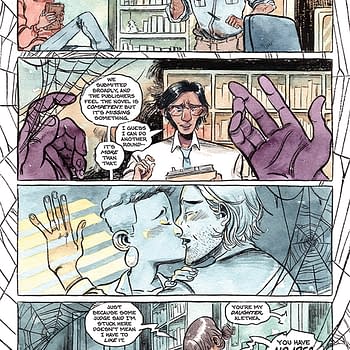Posted in: Comics | Tagged: sales, von allan
Bride Of The Return Of The Revenge Of The Monthly Comic Book Sales Article
We've been talking a lot lately about comics sales numbers here at Bleeding Cool. In the article "How Marvel Won The November 2016 Market Share," Bleeding Cool Rumormonger-In-Chief Rich Johnston told you how Marvel uses variants, discounts, and extra shipping free copies to spike sales numbers in the direct market. We also heard from Marvel Senior Vice President Tom Brevoort, who called the publicly available direct market sales numbers "not remotely accurate," as well as a response from Comichron's John Jackson Miller explaining how the estimates are arrived at and what they can be used for.
Now, Stargazer and Metal Gods creator Von Allan writes to Bleeding Cool with a story of how the Diamond sales charts can be misleading for indie comics sales as well:
I've been enjoying your various pieces on comic sales over on BC. One element that I don't think has been discussed is something that probably happens near the bottom of the sales charts. Diamond, because of their multiple warehousing, has various titles arriving and then re-shipping out to individual retailers at slightly different times. If this occurs at the end/beginning of a month, this can "break" sales totals over a two month period.
The easiest way to explain it is through an example: I shipped a total of 356 copies of Stargazer Volume 1 to Diamond in December 2010 (plus 27 freebie copies as part of a promotion I did with them). However, Diamond wanted me to ship some of them to Plattsburgh and some to Olive Branch. I did and the books arrived at slightly different times and then re-shipped out to retailers sometime after that. If I'm remembering right, some stores got theirs at the end of December '10 and others in the first two weeks of January '11.
There were enough total copies ordered of Stargazer v1 that it should have appeared in Diamond's/ICV2's/Comichron's graphic novel sales estimates for January 2011 (Stargazer v1 should have appeared around the 230th slot). It didn't. Nor did it appear in December 2010 or February 2011. My best guess (and it's only that) is that one warehouse recorded the sales (arrival date?) for December '10 and the other recorded it in January '11, "breaking" the totals over the two months. Neither warehouses individual totals were enough to qualify for ranking and so Stargazer v1 didn't.
I've always been curious about this. Does it still happen? If it does, how many titles are affected? It probably doesn't affect the higher selling titles (though it might), but might skew the interpretation of lower selling titles. Maybe.
All I really know is that Stargazer v1 never appeared in the charts and thus escaped analysis completely.
Weird, eh?
Weird indeed.
When it comes to Diamond's rankings and the sales estimates based on them, it's worth noting that these are numbers of books sold to retailers, not to actual readers, so they're already one step removed from representing actual readership. Of course, there's Bleeding Cool's Bestseller Lists, ranking comics sold on Wednesdays and Thursdays from a sample of comic shops, which you should check out to boost our own advance click estimates. We don't have an incentive variant to offer you, unfortunately.
Meanwhile, ICv2, another website that tracks and estimates sales numbers, released their analysis of comics sales and production this fall, noting that Marvel published 21% more books and DC 13% more than last year between September and November. In one of the most interesting parts of their analysis, which you can read in full here, Milton Griepp wrote:
There have also been price cuts by DC to $2.99 from $3.99 with its Rebirth launch, which certainly helps, and in fact, DC sales do seem to be holding up better than some others. We took a quick look at November numbers and found 24 DC titles with sales over 50,000 copies in November of 2016 vs. only five with sales over 50,000 copies in November of 2015. The reverse was true for Marvel, with 19 Marvel titles over 50,000 in November 2016 vs. 32 over 50,000 in 2015.
Flat sales overall have led Free Comic Book Day founder Joe Field to warn that some comic shops might close early next year to start off a potentially lean 2017. Despite hand-waving from Marvel about inaccurate sales estimates, things seem to look a little bleaker for the House of Ideas in 2016 with Civil War 2 than they did in 2006 when the original Civil War was being published.
Could it have anything to do with the fact that, ten years and dozens of super-mega-crossover events later, they're running basically the exact same story by the same writer creative braintrust for their big blockbuster event to shape the entire publishing line (and once again, it's late)? Another question: If the "real" numbers painted a significantly different picture of Marvel's sales than these inaccurate estimates, wouldn't Marvel be best positioned to set things straight? With that in mind, why haven't we heard much about digital sales? Marvel isn't exactly the humblest organization in the world, so if they're not explicitly bragging about something, what does that imply?
The comic book sales information available to the public may be flawed and inaccurate, but that doesn't necessarily mean that the conclusions drawn from them are wrong.













